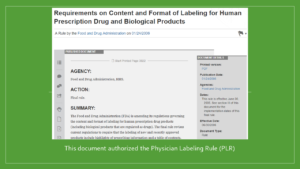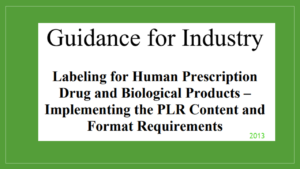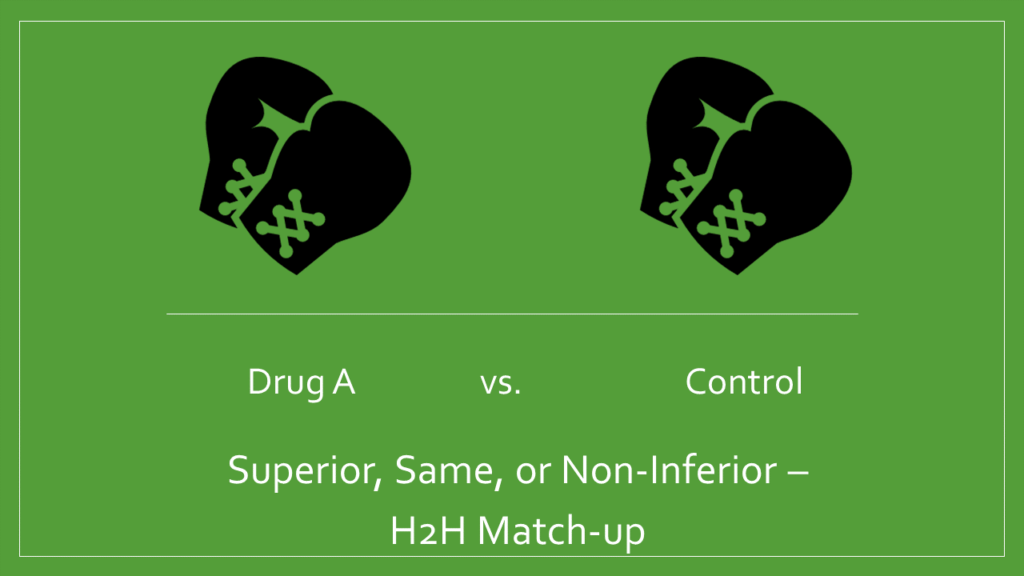The FDA issued new draft guidance last Friday along with a press release. Did you notice it?
No, not the one about biosimilars or off-label HEOR discussions. This guidance has the following title: ‘Indications and Usage Section of Labeling for Human Prescription Drug and biological Products – Content and Format.’ [1]
It is a mouthful, right?
The intent is to provide more concise and explicit descriptions of the conditions and populations for a specific drug indication. I had visions of infographic style labeling with clear and large icons to make scanning the document more accessible for clinicians (and the occasional patient that reads them). Nope. That is not where this is going.

Consider the following scenario:
A harried physician is seeing their 20th patient of the day. After obtaining a history and doing an exam, they need to determine a course of action. Several drugs may fit the patient’s needs. Which is the right one? Referencing their handy PDR app, they review drug options. Each one requires consulting multiple sections of the label which is hard to do on a small mobile device. The format eats into the physician’s productivity. It would be optimal if each indication statement had all the information the physician required to identify the appropriate patient for a drug.

Intent of the new FDA guidance
Medpage Today suggested that the new guidelines will give prescribers “more precise yet also more understandable information on which conditions a drug is approved to treat.” That sounds positive! Physician productivity is back up.

Jacqueline Corrigan-Curay, M.D., J.D., Director of the Office of Medical Policy in FDA’s Center for Drug Evaluation and Research commented, “FDA-approved labeling is the primary communication tools for providing information on the safe and effective use of drugs for the medical community.” [2] That is correct. A wide variety of audiences review drug labels. Writing for the different needs of each constituency is a bit tricky.
The guidance is 20 pages. That seems a little long to show the industry how to be more concise, but I anticipated some great before and after examples. Show a current label (or close replicas) and demonstrate future improvement.


The FDA released Product Label guidance in 2006 and updated it in 2013. The FDA plans a series of guidance documents in this series. The new guidance is merely the first – ‘starting at the top’ so to speak.
The formatting and language make it clear that this document is a creation of both physicians and lawyers. It is a little dense to get through, so I will highlight the necessary bits.
Purpose of the Indications and Usage statement
The entire package insert focuses on healthcare professionals. Public audiences are not the intended audience for product labels. You can see this clearly when you compare the package insert and the patient leaflet.

The statement should use high-level medical terms that are scientifically valid and recognized by health care providers.
The indications statement details appropriate drug use per the study materials reviewed by the FDA. The drug must treat, prevent, mitigate, cure, relieve symptoms, or diagnose a disease state.
The medical community must recognize the disease state, condition, or symptoms.
Level of Evidence Required
Statements in the Indication statement should be “based on adequate and well-controlled studies.” [3]
What is adequate and well-controlled? The answer differs based on the overall profile of the drug. Drug Sponsors have a lot of communication with the FDA during the drug application process and receive feedback on planned trial designs.
After submitting a drug for approval, no one wants surprises.
Drug sponsors must discuss the scope of their planned indication (what patients do they think their drug treats) with the assigned review division. In general, employ the best possible trial design every time.
Scope of the Indication Statement
The primary FDA mandate is protecting public health [4]. The organization is very conservative and does not ever want to walk back a decision. It is essential that the indication statement is unambiguous.
Often, study designs will exclude specific populations. Examples:
- Geriatric populations
- Pregnant women
- People with taking certain medications
- People previously diagnosed with other medical conditions
- Patients with different subtypes of a disease
The FDA can support a broad indication statement. Allergic rhinitis drugs are an excellent example of this kind of straightforward statement.

In other cases, there are more complex nuances to take into consideration.
In heart failure, the endpoints are not well standardized, and physicians need to know specifics.
In sleep, a drug may target sleep onset but not sleep maintenance. That would dictate which patient was a good fit for the drug.
The composite endpoint, MACE, is a single measure of effect in cardiovascular studies. MACE stands for ‘major adverse cardiac events,’ and the components of the endpoint including cardiovascular death, non-fatal myocardial infarction, and non-fatal stroke. In these trials, it is essential to know how the drug performed on the overall and individual components of the endpoint.
Some product labels require additional descriptors or qualifiers to identify the appropriate patient subpopulation. Examples would include:
- Hormone-refractory prostate cancer (prior history)
- history of coronary artery disease (previous history)
- …who have had an inadequate response to TNF antagonist therapy (prior therapy)
- Adjunct to surgery and radiation (adjunctive or concomitant therapy)
- Tumors are anaplastic lymphomas kinase (ALK)-positive by FDA approved test (required diagnostics)
- WHO Group 1 pulmonary arterial hypertension (disease classification)
- Moderate to severe plaque psoriasis (disease classification)
- Candidates for phototherapy or systemic therapy (health status)
- Immunocompetent (health status)
Same as study population
Example: Researchers conduct a clinical study on ‘participants with CIDP that had been on corticosteroid therapy.’ The FDA Indication statement may state: ‘Drug X is indicated for the treatment of patients with chronic inflammatory demyelinating polyneuropathy (CIDP).”
The Clinical Studies section of the label details the specifics of the populations assessed in clinical trials.
Broader than study population
Example: Early Phase IIb study assessed the drug in ‘adults (age 18-45) with unresectable and non-ablatable primary liver tumors.’ After all study data was analyzed, the indication read ‘adults (≥ 18 years) with unresectable and non-ablatable primary or secondary liver tumors of any histological subtype.’ Researchers may have observed that the drug was efficacious in a broader population than initially anticipated in the early clinical trial. The Indication statement requires a review of all available data.
Available information must not suggest that the drug was potentially risky in previously excluded populations.
Unless there is concrete evidence that taking the drug with concomitant drugs will result in harm, the indication should not preclude the use of concomitant medications.
If researchers find, and the FDA agrees, that the data is more generalizable than evaluated in a specific study, then the final indication may be broader. Examples would be:
- Tested in a subset of patients with a disease but disease process remains the same at different disease stages
- Mechanistic data on the drug
- Benefit: risk profile
NARROWER than study population
Example: Study enrolled patients ‘with confirmed recurrent or metastatic HNSCC (head and neck squamous cell carcinoma), aged at least 18 years.’ After completing all necessary clinical trials, the FDA approved the drug for ‘adults with metastatic head and neck squamous cell carcinoma.’ In this case, something in the information from the study suggested that the drug did not perform well in patients without metastasis.
Examples:
- Data are stratified in the analysis and found to benefit some groups more than others.
- Patients with a specific genomic marker if that marker is key to the drug’s efficacy
- Population with a history of myocardial infarction
Age Groups Included in Indication Statement
Study protocols define inclusion criteria related to age. In general, studies enroll patients 18 years or older. ‘Do No Harm’ takes on extra power when a child is a patient.
Babies, children, and adolescents cannot be assumed to react to drugs in the same way as an adult. Drugs metabolize differently in children, may have a different adverse event profile, and even require different dosing schedules. Regulations define the pediatric population as children ‘from birth to 16 years’. Teenagers aged 17 years fall into some strange time warp continuum.
For a specific drug multiple studies may be conducted, and individual trials may evaluate different patient populations.
Examples:
- Drug tested only in adult patients across multiple trials
- Studied in adults, but extrapolation to pediatric populations was possible based on safety and pK data
- Some studies in adults and other studies in pediatric populations
- Extrapolate pediatric trial results to a similar but different pediatric population

The indication should specify age parameters to use the drug. Based on the drug profile, the Indication statement may read:
Adults (Prevnar 13 label)
Adults x years and older (Engerix-B label)
Pediatric patients X years of age and older (Afluria Quadrivalent label)
Adults and pediatric patients x years of age and older (Viread label)
Limitations of Use
If you are thumbing through FDA product labels, and there is no reason you should be, you will not find a lot of Limitation of Use statements. Not all drugs require them.
A Limitation of Use is not a contraindication, warning, or precaution. There is no need to restate these stronger FDA warnings in the Limitations of Use statement, although there may be instances where other label sections contain more information on a Limitations of Use. Deleting repetitive text will help cut extra text from the label.
Limitations of use identify populations that should not use a drug. This statement is not intended to identify all the populations in which data for the drug is absent or inadequate. Can you imagine the length of the label if that was the expectation?

So, if they are relatively rare, when are they used? Regulations support their use when there is a widespread belief that a drug is efficacious, but the preponderance of evidence does not support the assertion, or the benefits do not outweigh risks.
- Uncertainty about using the drug in specific situations
- Example 1
- Drug X is indicated for the treatment of hypertension in adults and pediatric patients one year of age or older.
- Limitations of Use: In patients younger than one year of age, Drug X can adversely affect kidney development.
- Example 2
- Drug X is indicated in adults for the acute treatment of a migraine headache with or without aura.
- Limitations of Use: Multiple clinical trials failed to establish the effectiveness of Drug X for the prophylaxis of migraine headaches
- The drug does not have evidence of benefits known to occur with drugs in the same class
- Example
- Drug X is indicated as adjunctive therapy to diet to reduce elevated total cholesterol, LEL cholesterol, apolipoprotein B, and triglycerides and to increase HDL cholesterol in adult patients with primary hyperlipidemia or mixed lipidemia.
- Limitations of Use: The effect of Drug X on cardiovascular morbidity and mortality has not been determined.
- Drugs with dose, duration, or long-term use considerations
- Example 1
- Drug X is indicated for the management of elevated plasma uric acid levels in adult patients with tumor lysis syndrome.
- Limitations of Use: The development of anti-drug antibodies may neutralize the activity of Drug X if the patient receives more than a single course of treatment.
- Example 2
- Drug X is indicated for the treatment of severe spasticity in adult patients with spinal cord injury, brain injury, or multiple sclerosis.
- Limitations of Use: Before implantation of a device for chronic intrathecal infusion of Drug X, confirm a positive clinical response to Drug X in a screening phase.
- Example 1
- Example
- Example 1
Where possible, a limitation of use should be stated rather than narrowing the patient population in the Indication statement.
Referencing an Endpoint
When the benefit of the drug positively affects many symptoms of the disease, there is no need to list out each one or how each way the trial measured the outcome.
When a drug has only been demonstrated to affect specific signs, symptoms, or manifestations of the disease, then the Indication statement should specify those benefits.
Example: Drug X is indicated to improve walking in adult patients with multiple sclerosis.
When a drug reduces the risk of morbidity and mortality, that should be called out instead of writing a broad statement of benefits in the disease state.
Example: Drug X is indicated to reduce the risk of nonfatal myocardial infarction, fatal and nonfatal stroke, and revascularization procedures in adult patients with clinically evident coronary heart disease.
Drugs Undergoing an Accelerated Approval
The guidance provided six lines of text for this specific situation. Most of it was the reference to the FD&C act and 21 CFR 314.510 or 601.41.
In short, if there is uncertainty due to quick testing procedures, the Indication statement should reflect this uncertainty.
Products with Multiple Indications
There are many drugs with multiple indications. Carbamazepine, Sildenafil, Tadalafil, Bupropion, Gabapentin, and Selegiline are just some of the drug examples.
- How many indications?
- Are the disease states similar?
- Are the indications for different symptoms of the same disease state?
In general, drug sponsors should either assign a subsection to each indication (1.1 Disease A, 1.2 Disease B) or create a bulleted list.
It can get messy looking when one or more indication has Limitations to Use, so formatting may take some fine-tuning to make it look streamlined.
Comparisons Between Products
It is very unusual to have direct drug comparisons in the Indication statement. For the most part, drug companies do not conduct studies that statistically compare their drug (drug A) to a competitor (drug B) for US approval. You may hear these called Head to Head (H2H) studies.
In the EU, drugs under consideration must contain a non-inferiority analysis versus a single drug in the same category, but this is not the same as demonstrating statistical superiority.

What do I mean? A superiority analysis tests drug A in a group of patients. Drug A is the drug up for FDA approval. The trial compares Drug A to a control that is either a placebo or active control. Often, the active control is already on the market and would be a competitor to Drug A if it is approved. A different group of patients tests the control. A statistician calculates the number of patients required to be in each group.
When the trial is complete, and the study data is analyzed, the statistician will compare how well Drug A did against the control. If Drug A demonstrated a better outcome than the control in a statistically and/or clinically meaningful manner, then the drug is superior to the control.
A non-inferiority trial compares Drug A and active control. In some designs, the third group of patients receives a placebo. The statistical plan specifies how efficacious Drug A needs to be compared to the Control to be considered ‘non-inferior.’
In other words, the goal of this trial type is to see if Drug A is ‘acceptably worse’ than the reference drug. Defining that non-inferiority margin is chosen by the study team. That is a significant piece of information for healthcare professionals to have.
This trial design if a big gamble for the pharmaceutical company, so they are not generally completed until after a drug is already on the market.
So, if a drug sponsor determines that comparison language is appropriate, the drug package submitted to the FDA must contain evidence to support the statement.
For a comparison between drugs, “adequate and well-controlled studies must have been completed.”
When comparing the safety or effectiveness between biological products, statements “must be supported by substantial evidence of effectiveness.”
What is adequate and substantial? The answer differs based on the overall profile of the drug.
Special Snowflakes
There are always special snowflakes, aren’t there?
Antibacterial drugs must discuss a strategy to reduce the development of resistance
Single enantiomer products of a previously approved racemic drug must state the non-racemic product has not been approved, shown to be safe, or cleared as useful for the conditions treated by the racemic drug
Other FDA guidance documents come into play for specific indications.
Connection to Other Product Label Sections
FDA labels contain significant cross-referencing.
The Indication statement should not include study details that are more appropriate for the Clinical Data section. Likewise, Indications statement do not include disease definitions.
Warning for unapproved use of the drug:
The FDA may require additional language in the Warnings section reflecting instances where it is not appropriate to use the drug. A drug label with this structure suggests when the drug is commonly used off-label for a condition, and that use is risky. Healthcare providers need to be aware of this information so that they can serve their patients.
Recommended Language for Indication STatement
I already mentioned that each word is carefully selected to reside in a product label. The FDA calls out three words in particular:
- ‘Reduce the risk’ versus ‘prevent’ – the use of ‘prevent’ in the label implies a guarantee of success. Don’t use it.
- ‘Only’ – unnecessary with a clear and succinct Indications statement
- ‘Also indicated’ – the interpretation may be that the indication is less important than the prior indication
Rise of Drug Databases
The guidance points out that one positive of the revisions will be to “facilitate the indexing of indications in electronic drug databases.” What is that about?
The FDA was concerned about electronic information resources in 2006 when they issued the prior version of prescribing information guidance. [5]
Pharmacists heavily rely on drug databases. Drug compendiums provide information that has been filtered and summarized. They make a quick read of information on a drug.
Pharmacists rely on these database subscriptions to keep up with the variety of medical information being added to the field daily. In general, the database takes the most conservative s stance on any topic to ensure patient safety.
Before filing a prescription, pharmacists can check patient data for possible drug interactions.
How Does Industry create Product Labels?
Label development requires a lot of time and energy. The pharmaceutical company wants a label that they feel appropriately highlights the many benefits of the drug. The FDA ensures that the risks of taking the medication are adequately detailed.
There are many rounds of review and editing before the FDA receives a proposed label. Each word is weighed, scrutinized, and tested. The FDA goes through the document with a fine-toothed comb.
Does the evidence support the statements included?
Is the scientific evidence represented accurately?
Is the terminology clear?
How are they defining ‘adequate’ and ‘well-controlled’ for a specific drug? Sometimes the definitions differ between disease states, agencies, and industry experts.
Updates to the Indications Statement
Over time, drug use in the marketplace generates new data. Additional clinical trials also produce additional information. Real-world evidence from claims databases serves a critical data generation function. Adverse events reports provide risk information.
As more information becomes available, it may be necessary to update a drug label.
Next Steps for this Guidance
So, not any significant changes to the Indications statement. It will be an art to be as transparent as possible in the most succinct manner that will make the drug maker and FDA happy.
Will other sections have more apparent modifications? We will see.
Unresolved issues remain. Healthcare professionals prefer too much information versus too little. Repeating key statements increases the opportunity to see them when skimming the label.
Will pharmacists get the information they need to assist patients and physicians?
Will the evolution of the package insert increase understanding of proper drug utilization? Increase adherence? Likely no.
The agency, per the usual, will accept comments on the draft guidance for 60 days. After that time, the direction will become final.
I would love to hear your thoughts on the new guidance. Excited by the possibility? Underwhelmed? I look forward to reading you comments. Write away below!
REFERENCES
- FDA, Indications and Usage Section of Labeling for Human Prescription Drug and Biological Products – Content and Format, F.a.D. Administration, Editor. 2018, U.S. Depratment of Health and Human Services. p. 1-20.
- Mezher, M. Indications and Usage: FDA Issues Draft Labeling Guidance. 2018 July 6 [cited 2018 July 11]; Available from: https://www.raps.org/news-and-articles/news-articles/2018/7/fda-issues-guidance-on-indications-and-usage-secti.
- Food and Drug Administration, Indications and Usage Section of Labeling for Human Prescription Drug and Biological Products – Content and Format Guidance for Industry, F.a.D. Administration, Editor. 2018, Office of Medical Policy. p. 1-20.
- Food and Drug Administration. What We Do. [Website] 2018 March 28 [cited 2018 July 11]; Available from: https://www.fda.gov/aboutfda/whatwedo/.
- Food and Drug Administration. PLR Requirements for Prescribing Information. 2018 July 9 [cited 2018 July 11]; Available from: https://www.fda.gov/Drugs/GuidanceComplianceRegulatoryInformation/LawsActsandRules/ucm084159.htm.

